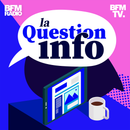It was one of the gifts of this “Secret Santa” organized among friends at the beginning of December: gummies made from THC, the main psychoactive compound in cannabis, and H4CBD, a cannabinoid derived from CBD.
Paranoia, feeling cold, convulsions and vomiting: the ten friends felt violent symptoms half an hour after consuming each of these over-the-counter candies. Seven of them had to be hospitalized. “I thought I was going to die,” one of the participants at this dinner confessed to Le Parisien.
Cannabis, cannabinoid, CBD, THC, H4CBD… But what exactly is it? BFMTV.com takes stock of these different terms and these different molecules, some of which are authorized, others in principle prohibited. With sometimes unclear regulations and not always clear business practices.
- Cannabis
Cannabis is a genus of flowering plants, also called hemp. It is used in the textile and pharmaceutical industries due to its high concentration of cannabinoids, chemical substances with psychoactive properties. Cannabis contains around sixty cannabinoids, explains Inserm.
It is particularly used in a medical setting, particularly with patients suffering from serious illnesses. Such as pain that no medication can relieve, in certain forms of epilepsy, but also in the case of cancer or in the context of palliative care.
In France, therapeutic cannabis has been tested for two years “in a limited framework”, says Health Insurance. These medicines are produced by identified and controlled laboratories. An experiment that should end in March 2024, adds the National Agency for the Safety of Medicines and Health Products (ANSM).
A cannabis for medical use, prescribed with a medical prescription, which has nothing to do with so-called “recreational” cannabis. As the French Observatory on drugs and addictive tendencies points out, despite the debate on the legalization of cannabis, it is still considered a drug. Consumed in the form of herb, resin or concentrates, it is therefore a narcotic whose use, incitement to consumption and sale are prohibited.
But for several years now, hemp-based products have been developed for “wellness” use.
- CBD
This “wellness” hemp is CBD or cannabidiol, one of the natural active compounds of the cannabis plant. But the big difference with the cannabis mentioned above is that CBD lacks a psychotropic effect. Therefore, it is not considered a narcotic.
Specifically, CBD is extracted from purified cannabis, “that is, free of other active compounds that may be present.” explains Health Insurance. It is then marketed in different presentations: oil, tablets, drops, candies or e-liquid. It is also legal to sell, buy and consume CBD flowers and leaves, this cannabis without narcotic properties.
If this substance is appreciated by its consumers for its supposed virtues against insomnia, stress and anxiety or chronic pain, “no scientific study formally confirms these benefits,” says Seguros de Salud. Considered a “novel food,” CBD is currently being evaluated by the European Food Safety Authority.
In addition, the Interministerial Mission to Combat Drugs and Addictive Behavior analyzed over-the-counter CBD products. Results: the composition of eight out of ten products is different from that indicated on the labeling.
- THC
THC (or tetrahydrocannabinol) is the main psychoactive molecule in cannabis. THC is a cannabinoid: cannabis contains about sixty. It is classified as a psychotropic drug: it is a narcotic, so its sale and consumption are prohibited in France.
Its concentration varies depending on the product: from 10% for grass and resin, to 30% for oil. “The higher the concentration, the more significant the effects of cannabis may be,” notes the drug information service.
THC was found in the gum consumed by the group of friends during “Secret Santa.” How to explain the presence of a prohibited substance in a product sold in France?
If THC is prohibited, products containing CBD with a THC content less than or equal to 0.3% are authorized. The problem is that the composition of these products is sometimes complex, points out Inserm.
“Products offered commercially and sold under the CBD label” always also “have some THC (although sometimes it is present in small amounts).” That is why driving after consuming CBD is also prohibited. remember Public Service.
And that is the difficulty. Wouldn’t consuming multiple CBD gummies, even with THC content below 0.3%, risk exceeding the thresholds? For chewing gum, “it is 26 mg, a fairly large dose for consumers who are little or not at all accustomed to it,” analyzes for Le Parisien Laurence Labat, head of the department of the biological toxicology laboratory at the Lariboisière hospital.
- The H.H.C.
Hexanhydrocannabinol (or HHC) is a synthetic molecule obtained from cannabis. Since last June, it has been considered a narcotic product in France, as are two of its derivatives: HHCO (HHC acetate) and HHCP (hexahydroxycannabiforol).
Therefore, the National Agency for the Safety of Medicines and Health Products (ANSM) considers that HHC presents “a risk of abuse and dependence equivalent to that of cannabis.” It is therefore prohibited to produce, sell or consume it in France.
HHC, which appeared on the US drug market in late 2021, was first detected in Europe in spring 2022 during a seizure by customs officials. Other countries have also banned it, including Austria, Belgium, Denmark and the United Kingdom.
The ANSM warns against the consumption of HHC or its derivatives, which exposes one to “risks”, such as “tremors, vomiting, anxiety, ‘bad trip’, mental confusion, general malaise, tachycardia, chest pain, high blood pressure.”
- H4CBD
H4CD is a new molecule, a synthetic cannabinoid derived from CBD that was found in the candies consumed by the group of friends. In this case, combined with THC, it potentially multiplied the effects. Big problem: this substance has never been studied, neither in humans nor in animals.
According The Parisian, H4CD could soon be added to the list of narcotics. Six cases of poisoning have been reported since June.
Source: BFM TV


